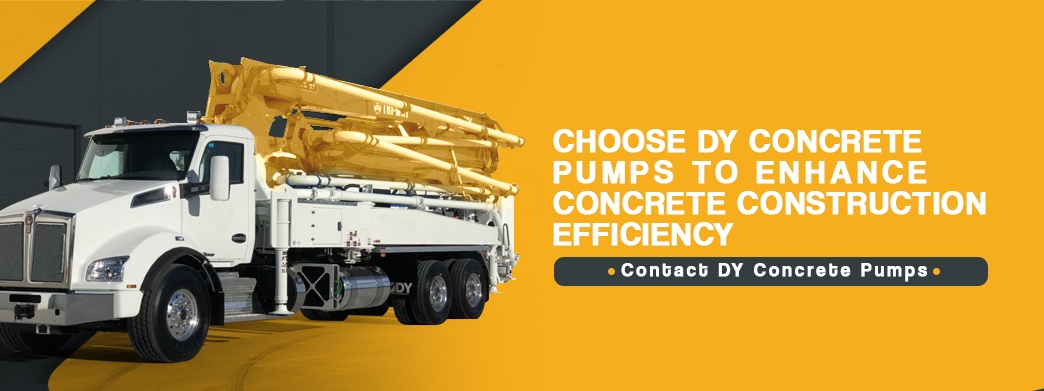Concrete vs. Other Construction Materials
Posted On: 05/01/2024 | Posted by: DY Concrete Pumps

Construction materials for any building project need to be readily available, cost-effective and durable. For much of human history, the only feasible options have been wood or stone — and wood has been effective enough to remain a construction staple today. Steel has become a relatively common construction material as well, thanks to several advantages over wood.
One material that hasn’t gotten enough credit is concrete. Long popular in Europe, concrete has traditionally been viewed as a utilitarian material suitable for use where aesthetics are at the bottom of the priority list. Most people associate concrete with parking structures, bunkers and other less-than-homey places and don’t realize it makes an ideal material for homes as well as utility buildings.
With continual advancements in concrete formulations, more and more beautiful concrete buildings prove this material can compete with others on every level.
Advantages of Concrete as a Construction Material
Once you realize concrete house construction doesn’t have to sacrifice aesthetics, the benefits of this building material become immediately evident. The following examples provide substantial food for thought on concrete vs. other materials.

1. Durability
Most concrete buildings are designed to last at least 30 years in service, although many last longer before deteriorating to the point of repair or replacement. It’s so long-lasting that buildings made of concrete are very rarely torn down because of deterioration. Concrete buildings are mostly repurposed when they become obsolete. Demolition will only occur to make way for a new construction project.
One of concrete’s most notable qualities is its resistance to damage. It is also highly resistant to abrasion from rain and humidity. It contains little to no organic content, meaning it is not vulnerable to rust and rot. Moisture is the only thing that can affect the joints, which need annual maintenance to ensure the building remains impermeable.
2. Fire Resistance
Water and wind aren’t the only elements concrete defies. Should the interior of a concrete building suffer from fire damage, the concrete shell will receive no significant damage from the flames. Home structure fires are an inherent hazard with most building materials. Each year, United States fire departments respond to more than 355,000 house fires.
While fire is a risk in any geographic location, those who live in areas with notable wildfire risk should give even more consideration to concrete when building a home. The devastating wildfire in northern California hundreds of homes and claimed several lives in the process. In the aftermath, many residents are considering how to fireproof new homes — and concrete makes an attractive option.
3. Cost
The up-front cost to build a new concrete home is higher than that of wood or steel frame homes. The difference in cost tends to fluctuate as the price of steel moves up and down, while the price of concrete stays relatively stable. At the national average, a concrete house can cost between 5% and 10% more than a steel or wood frame home.
When you’re already talking about hundreds of thousands of dollars, that small percentage can add up to a significant price tag. However, concrete homeowners enjoy a substantial reduction in energy costs over time. In other words, the upgrade to concrete pays for itself.
Insurance costs for concrete homes are notably lower as well since the houses are significantly less susceptible to damage of all varieties.
4. Construction Speed
The speed of construction for a concrete building depends on the type of concrete, but it’s generally comparable to wood frame construction and markedly faster than structural steel. Because steel must be fabricated off-site and transported, the process takes longer than pouring and erecting a concrete slab.
When using a cast-in-place concrete plan, builders can implement a two-day cycle to complete the project faster.
5. Energy Efficiency
Concrete is an effective insulator. It is an excellent material for regulating temperatures and keeping hot air in and cold air out. Concrete doesn’t have as many spaces for air to flow through, so less energy needs to be used to keep a concrete building hot or cold. The low permeability of concrete helps to maintain temperatures over a longer period of time without using extra power. For this reason, it is commonly used to make shelters.
These qualities mean that using concrete can help businesses and homeowners reduce their energy spending. Using insulating concrete form (ICFs) can offer additional insulation for better performance. Producing concrete is also more energy-efficient than making other types of building materials, like steel and aluminum.
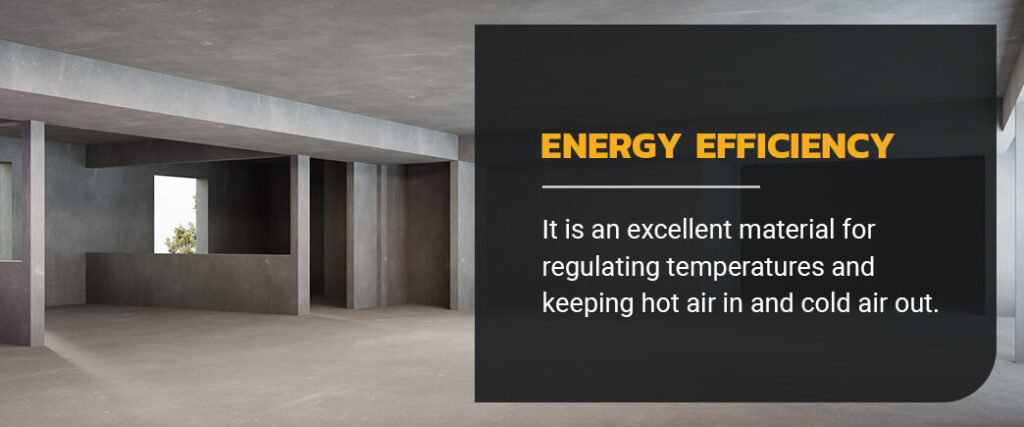
6. Versatility
Concrete is highly malleable when mixed and can take on various additives, appearances, surface textures and shapes. We see new types of concrete being made every year, including blends with high-performing characteristics to suit specific applications. Concrete can be used in specialty projects and adapted to fit even the most unique projects. Plus, it doesn’t need special conditions to set, so it can harden at ambient temperatures.
Characteristics like moisture and high-temperature resistance make concrete a good fit for settings with these demands, like underwater construction and high-heat factories.
7. Low Maintenance
Using concrete can significantly reduce the cost of building maintenance. There are many applications that can be used that will last for decades. Concrete can be coated or repainted for aesthetic reasons, but this is not required to maintain structural integrity.
Building owners may find that concrete construction lowers maintenance demands due to reduced risks of poor air quality, moisture damage, fading or wear from sunlight, pests and structural problems. As a result, homeowners and building managers may need to spend less on replacing components, setting up costly ventilation systems or spraying for vermin.
8. Resistance to Pests
A considerable benefit of concrete is its resistance to pests and insects. There are no known pests that prove a substantial threat to concrete — compared to wood, which is highly susceptible to pests like termites and rats. Using a material that can ward off these pests or not facilitate them can greatly increase a building’s life span. Additionally, concrete will not corrode when exposed to harmful chemicals. Pesticides and insecticides can be sprayed liberally around them without the risk of harming the integrity of the concrete.
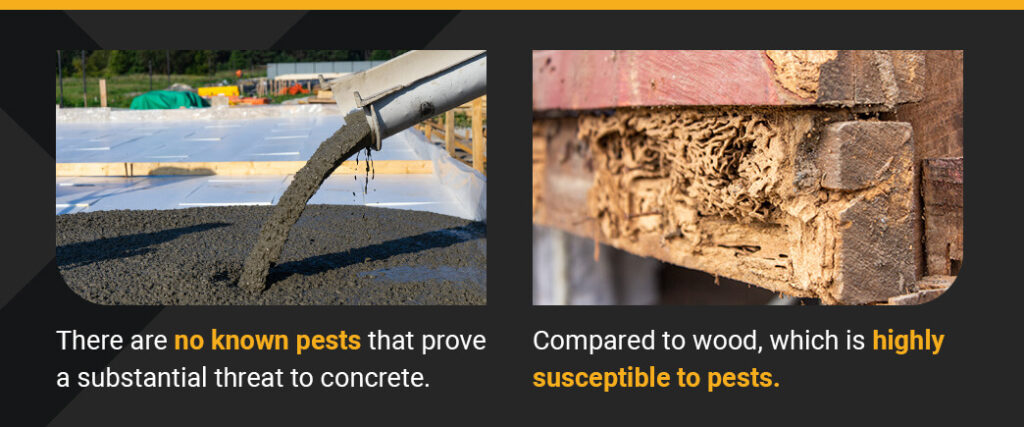
9. Fast Construction
Being a fast-setting material, one of concrete’s advantages is how it can be used for fast construction. Urgent and emergency repairs can be done quickly, thanks to how easy it is to use and how fast it sets.
Temporary structures are easily created with concrete. Things like road barriers, floor coverings, walls and anchors are often required in construction. Concrete makes sturdy, durable temporary structures that can be demolished when no longer needed. Safeguards and reliable blockades made with concrete are simple and cost-effective to set up.
10. High Resistance to Water
Concrete is highly resistant to water and is easy to waterproof. This is one of the biggest advantages of concrete, especially in areas prone to flooding. Concrete sidewalks are protected from water and salts, which is very useful in the winter. Pollutants that would corrode other materials will simply wash off waterproof concrete.
Waterproofing concrete involves sealing the pores that would absorb moisture. This also protects it from water freezing in the core and causing expansion and damage. By removing the risk of moisture, you also eliminate the risk of cracks.
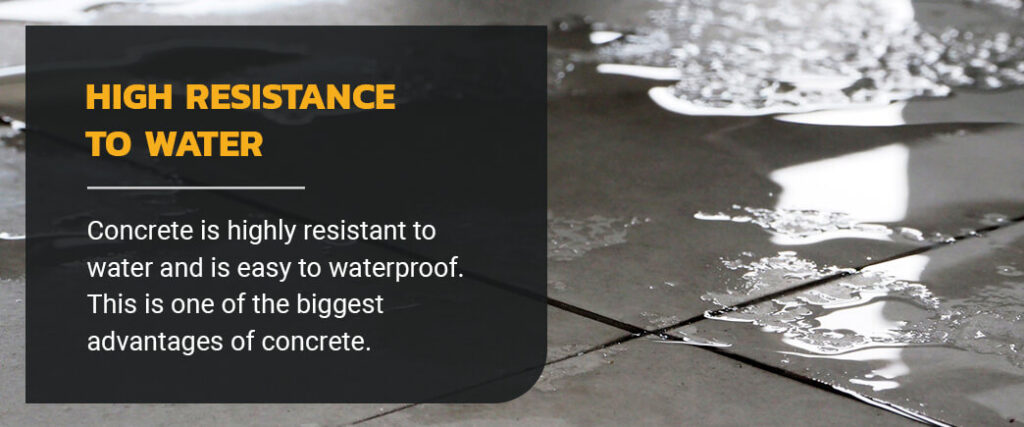
11. Long Service Life
Apart from their strength and durability, concrete has an incredibly long life span. This is one of the most advantageous uses of concrete in comparison to other building materials. Depending on how it is installed and what it’s used for, concrete can last anywhere from 30 to 100 years. Different concrete mixes are more durable than others based on what they are exposed to. Even in the most harsh and hazardous conditions, concrete will still last for a long time.
Capillary cavities can be found in cement and cause permeability. This can reduce concrete’s life span, but you can minimize the number of these cavities. By using as little water as possible when mixing the cement, you optimize the concrete’s structure and strength. Frequently wetting and drying concrete will prevent moisture in the early phases of setting the cement. This can improve its longevity.
Large Concrete Structure Construction Process

Concrete building construction for large structures differs in many ways from the traditional process, and there are multiple ways to go about it. The two most common types of concrete structures for residential and office buildings are tilt-up and ICF. Before beginning, both construction methods require workers to excavate the site and prep the subgrade. Once the site is ready, the two methods diverge.
1. Tilt-Up Construction Process
Tilt-up construction is almost self-explanatory. Once large slabs of concrete are dry, machinery tilts them up and into place. The process goes as follows:
- Workers first create footings for the slab panels. These wood bars define the size and shape of the panels. All doorways and windows are included in the initial form, so there’s no room for error in following the design.
- The workers incorporate the rebar lattices into the forms. They also create inserts where the crane will hold and lift the slab, as well as embeds where the panels will attach to floors, the roof and other panels.
- Once the forms are completely clean and dry, workers pour the concrete in and wait for the panels to dry.
- Workers remove the forms and attach cables to the crane.
- The crane lifts and tilts the slab until it hovers vertically above the ground, at which point workers push the slab into the right position.
- The crane carefully lowers the slab down. Workers brace the panel and connect it to the footing.
Once the crane disconnects from the finished panel, the crew is ready to rinse and repeat as many times as they can for the day.
2. ICF Construction Process
Insulated concrete forms come in a few different types, but they all function on the same design principle. Each block consists of two insulating faces, usually made of polystyrene. The two faces are connected by metal connectors, plastic or more polystyrene with empty space in the middle. The construction process is simple, but requires precision:
- After preparing the site, workers create a footer that will work with a particular ICF system.
- Workers stack the ICF units in layers. Many ICF blocks have interlocking grooves at the top and bottom to make stacking blocks fast and easy.
- Workers heavily brace walls to ensure they remain straight and install rebar in the blocks according to manufacturer specifications.
- Workers recheck bracing, and once they confirm the wall is still straight, it’s time to pour the concrete. A concrete pouring truck is traditional, but builders can simplify and speed up the process with the use of a concrete boom pump.
- Once the concrete dries and cures — usually within three to five days — the bracing comes off. The building is now ready for wiring through the foam surface, as well as for interior and exterior finishing.
Obstacles in the Concrete Construction Process
Building with concrete (especially ICF) is no more complicated than building with traditional materials. However, some unique issues can plague novice concrete builders. Here are a few tips to help things go smoothly for a beginner:
- Use enough fasteners: Attaching the recommended number of fasteners during ICF construction is time-consuming, and some builders will cut corners by ignoring the recommendations. This practice is dangerous and degrades the durability of the completed building.
- Triple-check your plans: The main disadvantage of concrete vs. other materials is the lack of flexibility for last-minute changes. If you find a flaw or mistake in your building plan, you won’t be able to alter it after the concrete starts flowing. Putting a window in the wrong place may not be a deal-breaker, but it’s critical to be more safe than sorry with concrete.
- Don’t risk blowouts: Experienced builders know how much pouring ICF blocks can handle at a time. Pushing that limit risks a “blowout,” where rapidly-poured concrete breaks through the polystyrene blocks. When this happens, the cost of wasted concrete and the effort of cleanup may cause profound delays.
As with any construction project, having an experienced professional in the loop makes costly mistakes less likely.
Common Applications of Concrete Construction
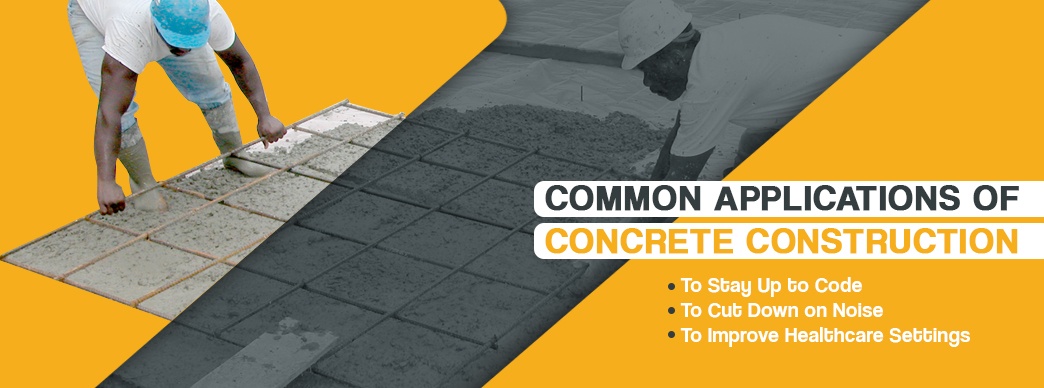
Now that the convenience and cost benefits of concrete house construction are clear, it’s worth exploring three of the more specific reasons people and companies choose concrete.
1. To Stay Up to Code
Most states and jurisdictions in the United States adopt some form of the codes set forth by the International Code Council (ICC). The ICC evaluates and updates building codes every three years, but there is no obligation for states and communities to actually follow those codes.
In 2016, Louisiana experienced catastrophic flooding after prolonged rainfall — 31 inches of rain in 15 hours led to mass power outages and flood damage to at least 40,000 homes. Yet despite the overwhelming destruction, Louisiana decided it wasn’t necessary to abide by the building code the ICC mandate requiring the bottoms of buildings to rise one foot above base flood elevations.
Many builders of homes or other constructions have good reason to want their buildings to exceed the minimum codes in their community. Reinforced concrete passes muster for any building code and often far exceeds the minimum requirements for ICC compliance. In areas prone to extreme weather events or temperatures, concrete is undoubtedly the best material for house construction.
2. To Cut Down on Noise
Concrete affords comfort in addition to safety. Noisy neighbors and loud music from the other room cause far less discord than they would in a traditionally framed home because concrete is excellent at sound dampening.
ICF blocks provide incredible noise reduction capabilities. This property makes concrete an ideal solution for settings that benefit from noise blocking. Think office buildings, schools or apartments.
3. To Improve Health Care Settings
Concrete even has health benefits over other materials, making it highly suitable for environments like hospitals and private practices. Concrete buildings have minimal levels of air infiltration. When air can’t get into a building, it’s easier to control and filter the air circulating indoors. Lack of air infiltration also significantly reduces unwanted moisture.
As a structural element, concrete offers better vibration control and sound dampening to benefit both patients and staff in a medical facility. Studies on noise levels in hospitals show too much commotion affects how well patients recover, and how well staff members can focus on their jobs. Reducing building vibration can improve the function of increasingly fine-tuned machines, as well as decrease strain on surgeons performing delicate procedures.
Certain forms of concrete featuring calcium aggregates also block more radiation than any other construction material. Facilities that perform radiation therapies are particularly suited to concrete builds.
Concrete vs. Wood
Despite being the material of choice today, wood construction comes with a host of pitfalls concrete avoids. When weighing a concrete vs. wood house, consider these factors:
- Pests: Termites are a major concern for wood-framed homeowners. The average cost of a termite treatment runs over $600, and an out-of-control infestation can end up costing upwards of $2,500, depending on the severity. Termites may have strong jaws, but they have no interest in or ability to chew through the walls or floor of a concrete home.
- Rot and mold: Prolonged humidity can cause a wood-framed house to experience persistent trouble with mold. In many cases, homeowners don’t realize they have a leak in their wood walls until health problems or visual indicators appear. By that point, mold may have already taken root. Concrete doesn’t absorb moisture, so there’s little chance of mold. And rot, of course, isn’t an issue.
- Longevity: Today’s wood-frame houses have lifespans of about 30 to 50 years on the low end. In concrete vs. wood construction, the longevity of concrete wins out by centuries.
Concrete generally wins out when it comes to strength, versatility, durability, soundproofing and energy efficiency. It can even offer cost savings for the initial build as well as maintenance and efficiency savings later on. Wood is lightweight and easy to work with, but those advantages fade with time and result in constructions that are more likely to fail or have problems, which adds to the overall costs.
At first, wood might seem like the greener choice since it’s renewable, but the topic is more complex than that. Longer-lasting buildings, increased energy efficiency, reduced energy demands and less waste all play into the carbon footprints of concrete and wood. Green concrete technologies are becoming more widely available, reducing carbon emissions during the production process. Plus, many types of concrete can be broken down and recycled, and some industrial waste is used as aggregate.
Concrete vs. Steel
In every way except cost, steel is a better option for construction than wood. The contest is much closer when it comes to concrete vs. steel construction. Here are some of the ways steel is at a disadvantage to concrete:
- Fire resistance: Steel-frame structures are non-combustible and undoubtedly more resistant to fire than wood. However, exposure to extremely high temperatures compromises the material’s integrity. To mitigate this risk, the International Building Code (IBC) mandates that steel components must be nested within additional flame-retardant materials.
- Corrosion: When water and steel come into contact, you’re faced with the possibility of corrosion. If such contact continues undiscovered, the steel faces increasing chances of weakening. Again, steel beats wood handily in a contest of ability to handle water contact, but reinforced concrete is almost entirely water-resistant.
- Lifetime cost: As concrete homes become more popular, costs are stabilizing and coming down. Steel, on the other hand, fluctuates greatly. The cost of concrete house construction is a little more upfront and provides permanent savings on energy and insurance. Considering the added safety, insulation and longevity you get from a concrete home, the lifetime cost of steel is significantly higher.
Concrete outperforms steel in these areas without much additional work. Steel is often faster to work with and has a high strength-to-weight ratio, but it doesn’t have the same safety profile or design flexibility as concrete. You can also get concrete from local sources, which keeps supply chains closer and uses less energy for transporting the material. Choose DY Concrete Pumps to Enhance Concrete Construction Efficiency
Choose DY Concrete Pumps to Enhance Concrete Construction Efficiency
Thinking of a building project that’s perfect for concrete? You may be interested in a concrete boom pump. A boom pump’s flexibility makes it possible to accurately lay concrete where ordinary trucks can’t go. Contact DY Concrete Pumps to learn more about how our equipment and services can fast-track your concrete construction project.


 1-844-397-8677
1-844-397-8677
